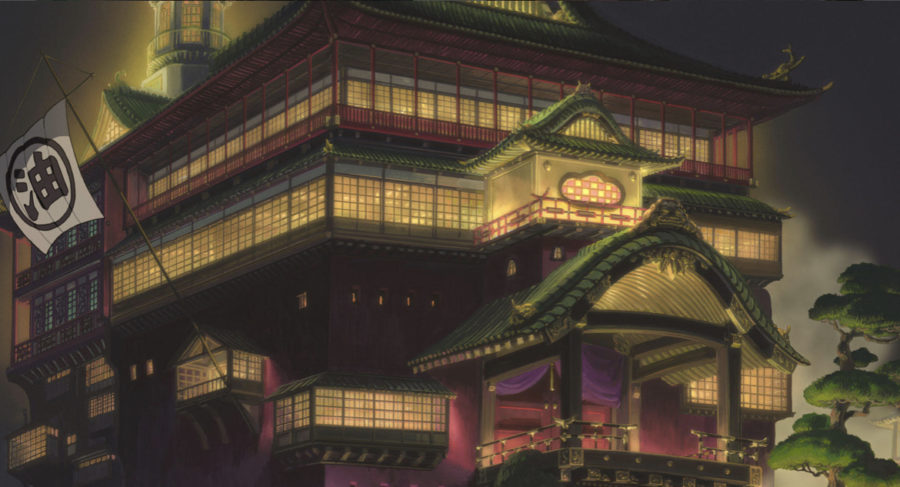Spirited Away: An Allegory for Capitalism
As Miyazaki’s most popular film, ‘Spirited Away’ offers viewers both breathtaking scenic frames and mental stimulation through the film’s nuanced criticisms of modern Japan.
Free Use Image, Provided by Studio Ghibli: https://www.ghibli.jp/info/013344/
In ‘Spirited Away,’ the grand bathhouse is illuminated at night time during business hours, but is closed during the day.
A single FMaj9 chord ripples through the air. For three seconds, the note lingers in a suspended breath until its poignant sharpness fades away. There is no mistaking it; this is Joe Hisaishi’s One Summer’s Day, the main theme of Hayao Miyazaki’s 2001 animated feature Spirited Away.
This Studio Ghibli movie requires no introduction. Though the company has produced eleven notable full-length features since its inception in 1985, Spirited Away is arguably Miyazaki’s magnum opus. For nineteen years, it was the highest-grossing film in Japan, beating out the Titanic, Harry Potter and the Philosopher’s Stone, and its predecessor Princess Mononoke. However, the film saw more than just domestic success. In 2003, it was crowned the Best Animated Feature at the 75th Academy Awards and remains the only non-English and hand-drawn movie to receive the honor.
It would be foolish to measure Spirited Away’s impact in awards only. Its real effect can be best seen at Hisaishi’s concerts. When he plays the iconic four-chord sequence, there is a collective gasp before nostalgia-infused tears stream down the audience’s faces. It is no longer Spirited Away’s soundtrack but the soundtrack of its fans’ lived experiences, childhood memories, pensive moods, and joyful moments.
To the horror of Studio Ghibli enthusiasts, I grew up on Disney productions — ensue the audible gasp. Despite thinking I was late to the game, I quickly concluded that Miyazaki’s films are confusing at any age. I was dumbfounded by Kiki’s Delivery Service as I waited for a villain that never appeared, and Howl’s Moving Castle is still an enigma with its subtle war themes.
Spirited Away is no different. On the surface, we follow Chihiro, a ten-year-old girl, who unknowingly wanders into the kami — a Japanese Shinto folklore spirit — world. After her parents are turned into pigs by the money-hungry witch Yubaba, Chihiro must work for her in a mystical bathhouse while finding her way back to the human world. But, to its die-hard fans, the coming-of-age adventure is an allegory depicting the dangers of capitalism.
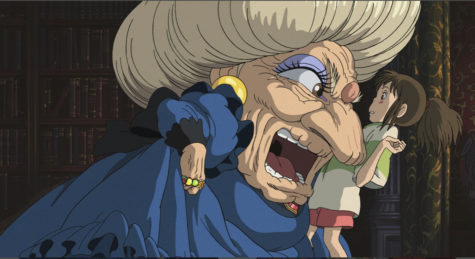
Bathhouses run on water, but Yubaba’s run on the lifeline of her workers. The first laborer we meet is Kamaji, a spider-like creature with six arms, in the scorching boiler room. Kamaji introduces himself as the “slave to the boilers.” He is at the heart of the operation, concocting herbal soaks and ensuring there is hot water for the guests. His six arms are symbolic of overwork — Kamaji does the labor of three people without any additional benefits, similar to how corporate employees are expected to do unpaid overtime.
Above ground, Chihiro comes to terms with her toxic work environment. She finds the staff scrubbing floors, preparing meals, and scraping sludge from tubs while her boss Yubaba sits in the penthouse, decorated in expensive western-style ornaments. In an attempt to get ahead, the workers are unsympathetic to Chihiro’s struggles, leaving her with the “worst” clients and the cheapest herbal formulas. At night, they sleep shoulder to shoulder in a cramped room. Here, the “every-man-for-themselves” mentality is prominent.
A side effect of hustle culture is the loss of individualism as work becomes closely tied to one’s identity. Spirited Away shows this in a literal sense. As Chihiro signs the employment contract, Yubaba magically steals the Japanese kanji character 尋 (“hiro” meaning “to inquire”) from her name, leaving only 千 (“sen” meaning “thousand”). Haku, Yubaba’s morally-ambiguous right-hand man, explains, “That’s how Yubaba controls you — by stealing your name.” The witch turns Chihiro into one of her thousand workers by taking her inquisitive childish wonder. The newly-named Sen is now just a number whose value is determined by her ability to bring the bathhouse money.
Miyazaki shows how tempting materialism can be through the gorgeous frames of abundance. Take, for example, the sequence where Chihiro’s parents are turned into pigs. Upon entering the kami realm, they are greeted by unattended stalls of food as an unassuming test. The meal proportions are dramatically overblown, adding to the supernatural nature of the spirit world. The size of a fish head is comparable to that of an adult grizzly, and the dishes are piled high on wide platters.
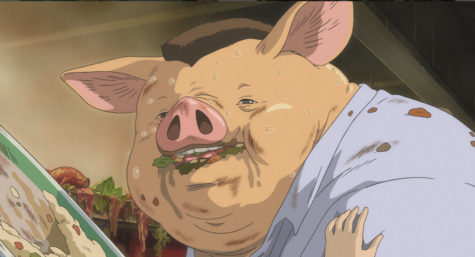
Her parents treat themselves to the buffet experience, gorging on chickens, fish cakes, and other unidentifiable meats without rest. They put very little thought into what they consume but rather how much they eat. When Chihiro confronts their gluttony, her father dismisses her with, “Don’t worry, your father’s here. I got credit cards and cash.” With his materialistic mindset, he sees the situation as an economic problem rather than a moral or social one.
In the few minutes that Chihiro leaves them alone, they are transformed into pigs, the classic symbol of greed. The beautiful scenes of abundance are now nauseating. Her father’s once-bright eyes are replaced by the absent-minded ones of a breeder pig, and he feeds into his animalistic instincts by continuing to stuff his face. The messy food stall becomes his pig pen. The squeals her father lets out are horrifyingly feral as a concealed hand whips him for his appetite.
Overconsumption is also illustrated in the masked ghost No-Face’s appearance. The spirit can produce gold from thin air. Not much else is known about the character other than that he is banned from entering the bathhouse. Unaware of this rule, the kind Chihiro lets him in. Though he is initially refused service for arriving after business hours, the staff quickly compromise their values upon learning of his fortune. They sing him songs of praise: “Welcome the rich man. He’s hard for you to miss. [He] keeps getting bigger, so there’s plenty to kiss!” The employees are dogs begging for gold nugget treats. However, like Chihiro’s parents, the workers are punished for their greed as No-Face begins eating them.
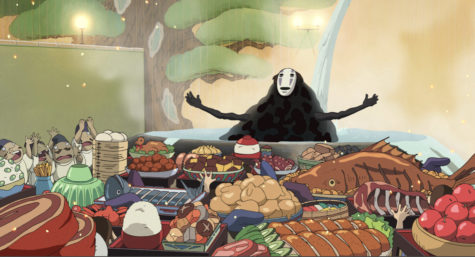
Miyazaki also depicts the other side of the coin — those with money can also be unhappy. In actuality, No-Face is a naive, lonely spirit. His extravagance is a product of his surroundings; he realizes that he could buy companionship through people’s love for money. He ate the workers in a fit of anger because he recognizes the artificiality of their kindness in comparison to Chihiro’s.
At the film’s core, Spirited Away is a critique of the failures of capitalism. Not only does the system promote materialism, but it also traps the low-class laborers at the bottom while lining the pockets of the rich. Lin, Chihiro’s mentor in the bathhouse, dreams of leaving but with no real plans of doing so. She announces, “I gotta get outta this place. Some day I’m getting on that train.” Though Lin works endlessly, Chihiro is the one who ultimately escapes because she rejects the capitalist system. Work is a trap, and hustle culture always bears rotten fruits.
As with all Miyazaki films, Spirited Away is a commentary on modernizing Japan. The story unfolds at the end of the country’s “lost decade,” a period of economic stagnation whose problems still plague Japan today. The unstable bubble economy had a promising start. During the 1980s, the economic superpower was the envy of the world. The increasing global popularity of Japanese goods like reliable Toyota cars heightened commercial activity and ushered in an age of prosperity and higher standards of living.
Economists like to refer to this era as an extended “party” — a dizzying period of unimaginable abundance (and an electrifying nightlife). To conceptualize the country’s obscene wealth, picture this: the Tokyo Imperial Palace (1.15 square kilometers) had a higher land value than all of California (423,970 square kilometers), America’s most populated state. Japanese investors also bought out movie studios like Columbia (Sony) Pictures, golf courses, and even landmarks like the Rockefeller Center. According to “How 1980s Japan Became History’s Wildest Party,” one had to wave a 10,000 yen bill (100 U.S. dollars) for a cab driver to even consider stopping in downtown Tokyo, and golf club memberships became a tradable asset worth 200 billion U.S. dollars. The values of simplicity and saving that had characterized the country were replaced by an infectious ravenous appetite.
But all good things must come to an end. The stock bubble crashed in late 1991, and Japan entered a recession. The country was now abundant in bankruptcies, and consumer spending on luxuries like cars and leisure activities dropped dramatically. The Lost Decade had arrived, bringing with it the cultural pessimism of an insecure job market and social immobility. Despite people’s efforts, it was difficult to rise up due to the broken economy. A life of extravagance and consumption had failed them.
Miyazaki calls out Japan’s cultural decay and lost identity in Spirited Away. There are two warring ideas at play — economic success versus spiritual heritage. The film starts in modern Japan. Chihiro and her parents drive a 1996 Audi A4 Quattro through green mountainous roads on the way to their new house. On Chihiro’s feet are a pair of Adidas, which suggests that her family is wealthy even during the Lost Decade. During the drive, they pass small roadside Shinto shrines which her parents describe as “houses for guardian spirits” with the same tone as a non-believer. They represent a new materialistic Japan, one that turned its back on traditions and spirituality.
The differing ideologies are reflected in the architecture as well. The buildings are a Frankenstein mix of traditional wooden structures with western influences such as Giyaman stained glass windows, and the use of stone, brick, and glass. Yubaba’s room is decorated with lush tapestries, ornate carpets, and extravagant lamps straight out of a King Louis XIV painting. She even wears a royal blue dress with jewelry adoring every finger. Meanwhile, her staff occupies tatami rooms with sliding doors. They all own the same pink Suikans, a tunic that servants of court nobles wore during the Heian period. The contrast between the two eras is clear. The West now has a chokehold grasp on Japanese culture.
The bathhouse’s weary kami clients demonstrate the erosion of heritage as well. As the number of Shinto followers decreases, fewer people praying to the spirits and maintaining the shrines. In the film, the decline in the kamis’ power manifests physically as exhaustion and aching bodies. The purpose of the bathhouse is also telling in itself: spirits come to cleanse themselves of the modern world. On a rainy day, a stink spirit (a slothish, smelly sludge) appears, and Chihiro is ordered to service it. Though thanks to her attention to detail, we learn that the stench masks a noble river spirit that had been polluted by human garbage. As Miyazaki once said, “In my grandparents’ time, it was believed that spirits existed everywhere […] in trees, rivers, insects, wells, anything […] I like the idea that we should all treasure everything because spirits might exist there, and we should treasure everything because there is a kind of life to everything.” With the rise of consumerism, we degrade nature as is shown in the stink spirit.
Independent music journalist Zim Ahmadi said, “There are so many themes within this film and they’ve all been talked about to death – from the liminal stage between childhood and adulthood manifested through Chihiro’s journey in the bathhouse, the 80s consumer bubble in Japan that fed Miyazaki’s criticism of greed, pollution via the defilement of Kami spirits […] a critique of identity dissolution within capitalism with Haku and Chihiro forgetting their old selves after having their name changed, etc. [It is] probably the most multi-faceted hydra monster of all the Ghibli movies.”
While the film is not outright anti-capitalist, it does suggest that technological progress offers a hollow promise of happiness. Despite this, it is easy to see why many get lost in the bustle of city life. I love watching films set in the late 1900s because there is a tangible hopeful energy in the air. People are adapting to a developing world with big dreams for the future. They leave behind their small-town communities for the global stage, and the youth bring with them a sense of hearty recklessness. However, in our current day, industrialization translates into overwork, a familiar value to Yubaba’s workers.
Miyazaki’s warning of hustle culture can be seen in the Great Resignation. Beginning in early 2021, employees began resigning from their jobs en masse. Many cited career immobility, hostile work environments, and changing post-pandemic priorities as the main reasons. Those who can afford it are reassessing their lives to make room for family, passion projects, and self-care. In “Welcome to the YOLO Economy,” Christina Wallace from Harvard Business School, explains that “younger people […] have been told to work hard, pay off your loans and someday you’ll get to enjoy your life, a lot of them are questioning that equation. What if they want to be happy right now?”
Along with those who are directly resigning, there are many “quiet quitters” as well. These individuals meet only the bare minimum of their job description. They set boundaries between their office and personal hours by avoiding overtime calls/ emails because they recognize the futility of working too much, unlike the trapped bathhouse employees. Miyazaki argues, “Our lives are like the wind […] or like sounds. We come into being, resonate with each other […] Then fade away.”
Happiness is also often higher in countries where work plays a smaller part in one’s identity. In the 2017-2019 World Happiness Report, Sweden ranked 7th while the U.S. took 18th place. Like the rankings, Sweden’s work-life balance is far ahead of other countries with its emphasis on family and well-being and five-week paid vacations.
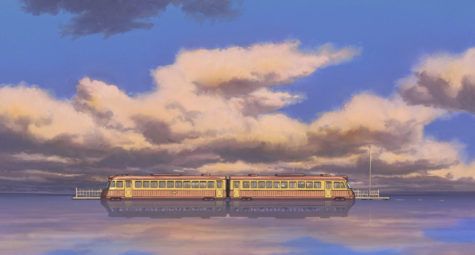
Spirited Away invites viewers to be more mindful, and this is echoed in the movie’s layout. At the climax, No-Face is seen chasing Chihiro through the bathhouse while wreaking havoc everywhere. But immediately following that is an idyllic sequence where the two board a waterborne train. The tracks are covered by a thin layer of water across a wide ocean expanse. The area surrounding the tracks appears to have more depth, creating the illusion that the train exists in an intangible space between the earth and the sky. For three minutes, there is an easy silence aside from the shuffling of passengers and the rumble of the tracks disappearing behind them. These silent scenes give the audience time to digest the earlier elements and embody the film’s message of reflection and spirituality.
In an interview with American film critic Roger Ebert, Miyazaki said, “We have a word for that in Japanese. It’s called ma. Emptiness. It’s there intentionally. [Claps his hands] The time in between my clapping is ma. If you just have non-stop action with no breathing space at all, it’s just busyness, but if you take a moment, then the tension building in the film can grow into a wider dimension.”
Ma does not only exist in films but is present in our daily lives as well. In my own life, my worries are cast aside for the hour that I’m on the school bus heading home. Though far from the aesthetic water-floating train sequence, I find my calm in the trees running by, the roaring of the engine, and the mindless haze that overtakes my brain as I stare at the setting sun. The motherly rocking sensation and white noise dull my senses, and I’m forced to surrender my productivity. Moments of nothingness like this forces us to take a step back and just breathe.
It should be noted that neither Miyazaki nor I am advocating for laziness. Hard work is a virtue, but success should never come at the cost of overworking oneself. The timelessness of Spirited Away mirrors its timeless truths on hustle culture, the failures of capitalism, and the degradation of spirituality. Though nihilistic, there is beauty in Miyazaki’s vision for the future. “Modern life is so thin and shallow and fake. I look forward to when developers go bankrupt, Japan gets poorer and wild grasses take over.”
To watch Spirited Away on HBO Max (subscription required), click HERE.
As Miyazaki once said, “In my grandparents’ time, it was believed that spirits existed everywhere […] in trees, rivers, insects, wells, anything […] I like the idea that we should all treasure everything because spirits might exist there, and we should treasure everything because there is a kind of life to everything.”
Nicole Zhou is the Editor-in-Chief for ‘The Observatory' yearbook and a Staff Reporter for 'The Science Survey' newspaper. This is her third year revising...

